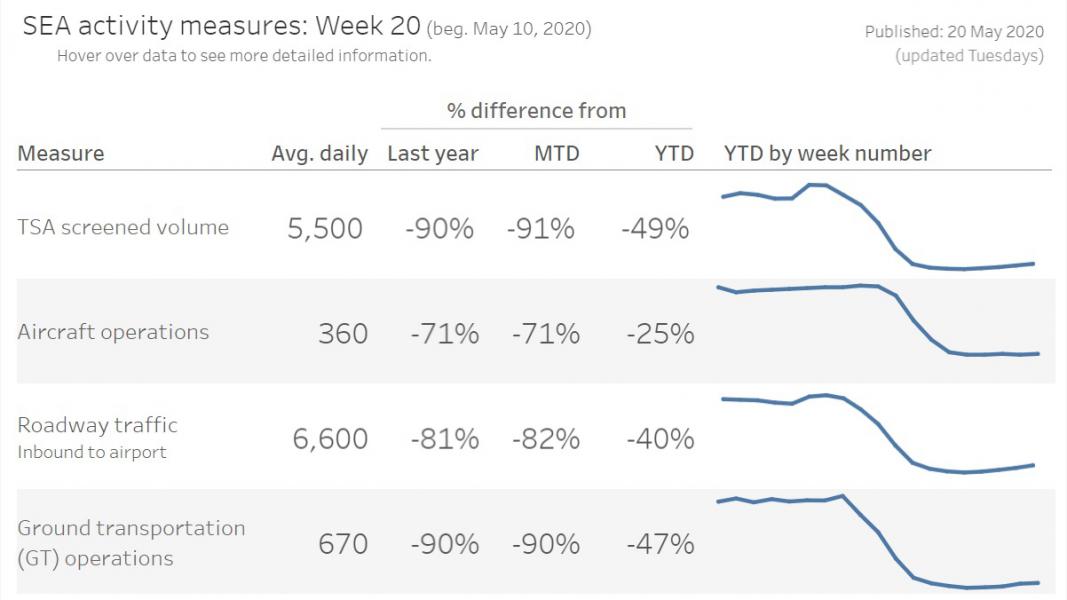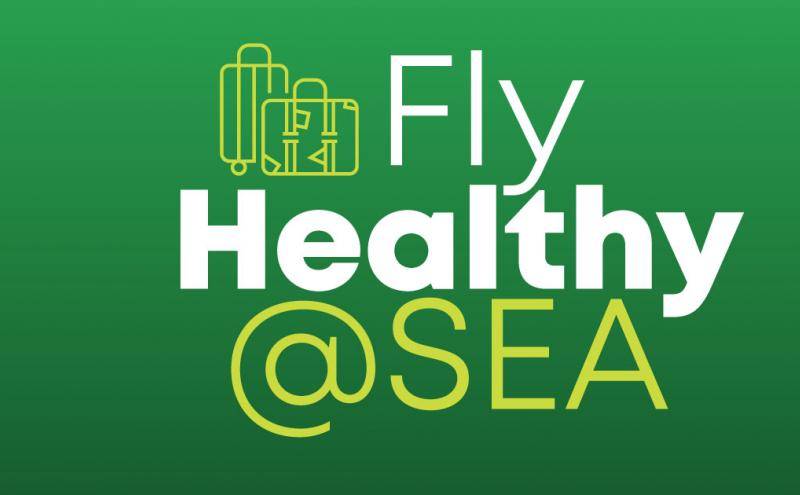
Usually this time of year at Seattle-Tacoma International Airport (SEA), we share tips for passengers navigating a bustling airport ahead of Memorial Day weekend. Today, we are sharing the data that illustrates how the airport is operating to meet essential trade, travel, and economic needs of the Puget Sound region while experiencing the ramifications of the global pandemic. The public dashboard, built to provide local governments and industries with key indicators as they track the recovery, shows the dramatic drop in passenger volume down to a 53-year low.
Most passengers continue to follow guidance to avoid non-essential travel, actions that help us maintain the health and safety of those performing essential tasks. About 260,000 passengers travelled through SEA in April of 2020, which is a decrease of 93.6 percent from the same month last year. The last time April passenger volumes were at a similar level was 53 years ago, in 1967.
Forecasts show passenger volume increasing slightly this month with as many as 8,000 departing screened passengers on the busiest May travel days. In May of 2019, SEA averaged almost 53,000 departing screened passengers.
“The airport economy provides jobs, sales, and tax revenue for our whole region,” said SEA Managing Director Lance Lyttle. “Publishing key data on a weekly dashboard gives local governments and industries valuable, real-time activity indicators to help track the recovery. I am heartened that our passenger numbers are gradually increasing.”
State of SEA by the Numbers
Passenger and Cargo Data for April 2020
- About 260,000 passengers traveled through SEA in April of 2020, down 93.6 percent from the same month last year
- Domestic passenger traffic was down 93.1 percent and international traffic was down 97.1 percent
- Passenger load factor was 14.6 percent, down from 86.2 percent in April 2019
- Aircraft operations (takeoffs and landings) decreased 65.9 percent in April 2020 compared to same month last year with about 400 daily operations
- Air cargo, including freight and mail, decreased 9.6 percent from April 2019; although, domestic air cargo increased 4.7 percent and international decreased 45.1 percent
- Over 9.4 million air passengers traveled through SEA from January to April 2020, a 36.4 percent decrease from the first four months of 2019
Current Operations
- Screened passenger volume at SEA averaged 5,500 last week, down 90 percent from the same week in 2019
- Last week’s volume is more than double SEA’s lowest level of 2,600 screened passengers the week of April 12
- Takeoffs and landings (aircraft operations) averaged 360 per day last week, a reduction of 71 percent from the same week in 2019
- Roadway traffic inbound to the airport averaged 6,600 vehicles per day last week, a decrease of 81 percent from the same week last year
- Ground transportation (e.g. taxis, courtesy shuttles) operations averaged 670 per day last week, a reduction of 90 percent from the same week in 2019
FlyHealthy @ SEA
Safety and well-being come first at Seattle-Tacoma International Airport. SEA looks forward to the gradual easing of travel restrictions as our region and country stop the spread of COVID-19, but we are using this time to prepare for the next phase of re-opening our economy and getting ready for higher volumes of activity at the airport.
FlyHealthy@SEA is a multi-phased strategy to ensure the health and well-being of passengers, visitors and workers. We took immediate actions. The next time travelers visit SEA, the experience will look and feel different, including:
- Passengers, visitors, and workers are required to wear face coverings in the public areas of SEA
- Signage for reminders and spacing to honor physical distancing
- Plastic protective barriers that buffer interactions between travelers and airport employees
- Frequent disinfection with medical-grade cleaning products
- Added 250 hand sanitizer stations throughout the terminal. Download the SEA App with our interactive map of hand sanitizer locations.
We will reconfigure spaces to support physical distancing in queues, seating areas, and while moving through the terminal by June 1. We will have a plan to implement temperature checks for departing domestic and arriving international passengers by June 9.

FlyHealthy @ SEA by the Numbers
- Installed 100 percent of 240 interim signs
- Deployed 100 percent of 450 interim floor markings for physical distancing
- Deployed 75 percent of 800 permanent floor markings for physical distancing
- Installed 45 percent of 178 plastic protective barriers that buffer interactions between travelers and airport employees
- 5,720 hours spent cleaning and disinfecting the buses and terminal at SEA each week, 85,800 total hours since February
- Spritzed, sprayed, and dispensed 706 gallons of hand sanitizer, over 4,200 ounces of disinfecting spray and 700 containers of sanitizer wipes in response to COVID-19
- Added 250 hand sanitizer stations throughout the terminal




